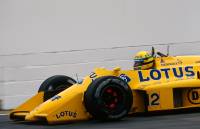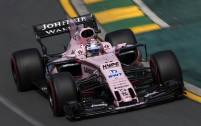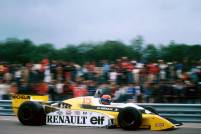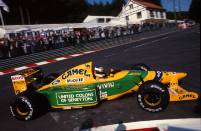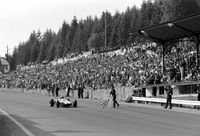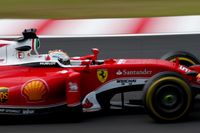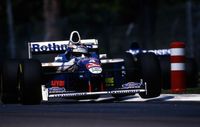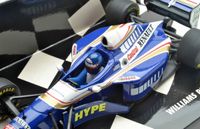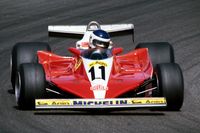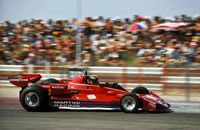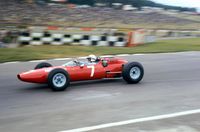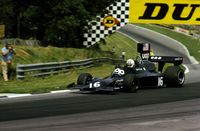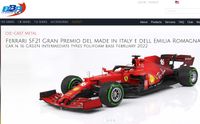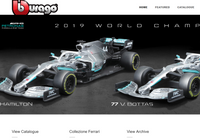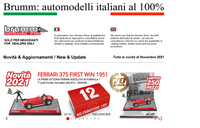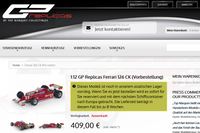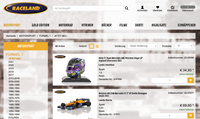Blogs 2017
Tobacco advertisment on modelcars: yes or no?
When Gold Leaf first appeared on Graham Hill's Lotus in 1968 nobody bothered. Smoking was «in». And the thought that the smokery might be harmful to health was foreign to most people. Tobacco advertising was part of everyday life. Also in Formula One. Gold Leaf was followed by John Player Special. And soon after Marlboro whose partnership with McLaren lasted 24 years. In the late 1980s and early 1990s many teams were linked to a cigarette brand. Formula One was smoking like there's no tomorrow. But at one point no longer everywhere. In countries like Germany or Great Britain suddenly tobacco advertising at Formula One Grands Prix was forbidden. And in the following years other countries followed that example. At the end of 2006 two of the last tobacco giants disappeared: Mild Seven (Renault) and Lucky Strike (BAR). Only Marlboro remained. Where the lettering of the most famous brand of Philip Morris International are no longer to be seen on the Ferrari. Even not in countries where it would be legally permitted. Ferrari just wants to avoid any legal trouble with the EU. First of all because all the races are shown in countries where a ban applies.
«Quartzo launches its historic models almost
every time with original tobacco advertising.» f1modelcars.com
The increasingly numerous prohibitions also had an impact on the modelcar industry. At the end of the eighties it was more or less forbidden to put tobacco advertising on modelcars. Onyx, Mira and Guisval were the last ones in 1988/1989 which put stickers from Marlboro and Camel on its modelcars. As the number of races in which the teams had to do without their cigarette sponsors grew steadily, creativity was needed. Jordan for example was sponsored by Benson&Hedges from 1996 on. So in 1997 they put Bitten&Hisses (later Buzzin&Hornets) on their cars whenever they had to race on a circuit where tobacco advertisment was banned. These modifications also helped the modelcar manufacturers. Because they were legal the models were allowed to be made as they were used in the tobacco-free Grand Prix. Other modelcar manufactures themselves became inventive. The Spanish manufacturer Mira for example changed Camel into Pamel on their Lotus 99T. And on the black Lotus of Ayrton Senna the year before you could read John Mira Special instead of John Player Special.
For us collectors the tobacco advertising ban on modelcars is a joke. And it is annoying at the same time. Again and again the manufacturers try to avoid the prohibition in order to offer their customers a model that is as true to the original as possible. Spark goes so far as to add the appropriate decals. This way seems to be reasonably legal. The models can be offered online or in modelcar shop without the manufacturer being accused of promoting the tobacco industry. But that's all absurd. The best example of this is the Ligier JS19 from 1982. Spark released this model with the lettering GITAN...S. The missing E was included as a decal. I think anyone who saw the model in a display immediately knew it was a car with cigarette advertising. The missing E would never have prevented anybody from starting to smoke. What leads my to the question: Do modelcars with tobacco advertising seduce anyone to smoke?
Of course there are always loopholes. And some manufacturers also seem to have no fear of contact with the strict rule guards of the EU. Quartzo (founded in Portugal, now part of the Sunstar Group in Macau) launches its historic models almost every time with original tobacco advertising. Lucky Strike, John Player Special or Gold Leaf: The models look like the originals. The same with the rally-cars. Quartzo does not seem to care about prohibitions. Whether Ford Escort with Rothmans or Belga lettering or Audi Quattro with R6 logos – you almost get the impression: the more unknown the cigarette brand is the greater the chance that the model cars will be provided with original stickers. From the viewpoint of a collector a very brave gesture. After all we all want to hold a miniature in its original delivery in our hands. #18th December 2017
Als Gold Leaf bei Lotus erstmals 1968 auf dem Dienstwagen von Graham Hill auftauchte, störte sich niemand daran. Rauchen war «in». Und der Gedanke daran, dass die Qualmerei gesundheitsschädigend sein könnte, war den meisten fremd. Tabakwerbung gehörte zum Alltag wie die Wurst zum Semmel. Auch oder gerade in der Formel 1. Auf Gold Leaf folgte schon bald John Player Special. Und kurz darauf Marlboro, deren Partnerschaft mit McLaren 24 Jahre dauerte. Ende der Achtziger-, Anfang der Neunzigerjahre waren viele Teams mit einer Zigarettenmarke verbandelt. Die Formel 1 rauchte, was das Zeug hielt. Doch längst nicht mehr überall. In Ländern wie Deutschland oder Großbritannien durfte bei den Grands Prix plötzlich keine Tabakwerbung mehr gemacht werden. Und in den Folgejahren zogen andere Länder nach. Ende 2006 verschwanden mit Mild Seven (Renault) und Lucky Strike (BAR) zwei der letzten Tabakgiganten. Geblieben ist nur Marlboro. Wobei die Schriftzüge der bekanntesten Zigarettenmarke aus dem Hause Philip Morris International längst nicht mehr auf den Ferrari zu sehen sind. Und das sogar in Ländern, in denen es gesetzlich erlaubt wäre. Ferrari will einfach jeden juristischen Ärger mit der EU vermeiden. Schließlich werden die Rennen ja auch in den Ländern gezeigt, in denen ein Verbot gilt.
«Quartzo bedruckt seine historischen Modellautos fast
ausnahmslos mit Zigarettenwerbung.» f1modelcars.com
Die immer zahlreicher gewordenen Verbote hatten auch Einfluss auf die Modellautoindustrie. Ende der Achtzigerjahre war es um Schriftzüge aus der Tabakindustrie mehr oder weniger geschehen. Onyx, Mira und Guisval hatten als letzte Mohikaner 1988/1989 noch für Marlboro und Camel geworben. Da die Zahl der Rennen, in denen die Teams ohne ihre Zigarettensponsoren auskommen mussten, stetig wuchs, war Kreativität gefragt. Bei Jordan beispielsweise wurde 1997 aus Benson&Hedges, dort wo Tabakwerbung verboten war, Bitten&Hisses (später Buzzin&Hornets). Diese Wortspiele halfen auch den Modellautoherstellern. Da sie legal waren, durften die Modelle so hergestellt werden, wie sie bei den tabakfreien GP zum Einsatz kamen. Andere Modellautomanufakturen wurden selber erfinderisch. Der spanische Hersteller Mira Zum Beispiel beklebte den Lotus 99T mit den Schriftzügen Pamel statt Camel oder das Vorgängermodell mit John Mira Special statt John Player Special.
Für uns Sammler ist das Tabakwerbeverbot auf Modellautos ein Scherz. Und ein Ärgernis zugleich. Immer wieder versuchen die Hersteller deshalb das Verbot so gut es geht zu umgehen, um ihren Kunden ein möglichst originalgetreues Modell anzubieten. Spark geht so weit, dass man die passenden Decals beilegt. Dieser Weg scheint halbwegs legal zu sein. Die Modelle können im Internet oder in Modellautofachläden angeboten werden, ohne dass man dem Hersteller vorwerfen könnte, er mache Werbung für die Tabakindustrie. Doch das ist alles irgendwie absurd. Das beste Beispiel dafür: Der Ligier JS19 von 1982. Spark lieferte dieses Modell mit dem Schriftzug GITAN...S aus. Das fehlende E war als Decal beigelegt. Ich glaube, jeder, der das Modell in einer Auslage sah, wusste sofort, dass es sich in dem Fall um Zigarettenwerbung handelt. Das fehlende E hätte ihn wohl nie im Leben daran gehindert, mit dem Rauchen zu beginnen. Vorausgesetzt Modellautos mit Tabakwerbung verführen überhaupt jemanden zum Rauchen.
Schlupflöcher scheint es immer wieder zu geben. Und einige Hersteller scheinen auch keine Berührungsängste mit den strengen Regelhütern der EU zu haben. Quartzo (in Portugal gegründet, heute Teil der Sunstar Group aus Macau) bedruckt seine historischen Modelle fast ausnahmslos mit Zigarettenwerbung. Ob Lucky Strike, John Player Special oder Gold Leaf: Die Modelle werden originalgetreu aus der Garage geschoben. Auch im Rallye-Bereich schert sich Quartzo offenbar nicht um Verbote. Ob Ford Escort mit Rothmans- oder Belga-Schriftzügen oder Audi Quattro mit R6-Logos – fast hat man den Eindruck: Je unbekannter die Zigarettenmarke, desto größer die Chance, dass die Modellautos mit originalen Stickern versehen werden. Uns Sammlern kann es recht sein. Schließlich wollen wir doch alle eine Miniatur in originaler Bedruckung in Händen halten. #18. Dezember 2017
Is pink really beautiful?
Pink is not everyone's color. Especially not in racing. When Force India announced its partnership with BWT some gave a sniff at the idea that there will be a pink Formula One car. In the meantime most of the fans are used to it. Or the pink of main sponsor BWT which is worth around 15 million Euro looks better than most people expected. In fact it's the first all-pink Formula One car. In 1992 when Damon Hill gave its debut at Brabham, the British squad had a car which was half pink and half blue. Three years later the FA16 made by Footwork was equipped with a pink nosecone. The former Arrows team had some advertising of Hype, an manufacturer of energydrinks. By the way: Hype seems to have no fear of contact with this special color. In 2017 the company of former Formula One driver Bertrand Gachot promotes his cans on the Force India. Even Jaguar once relied on pink. In 2003 the company logo was completely in pink. Sponsor Steinmetz had a pink diamond to offer that they wanted to advertise at the Grand Prix of Monaco. Also the Koijma of Japanese driver Noritake Takahara had some pink sponsor stickers when he raced at Mount Fuji in 1977. He didn't have much luck with this colour. Takahara retired after only one lap due to a collision. Apart from a few splashes on the Benetton B186 and B187 and the Onyx from 1989/1990 there are no other Formula One cars in pink.
In the USA it is another story. There are some pink race cars from time to time. And these cars are not only raced by women like Danica Patrick or Pippa Mann. Even hard-boiled guys like Kyle Busch, Robby Gordon or Matt Kenseth were put in pink cars – always depending on the sponsor and the season. Because in October pink is in vogue in the USA. The colour promotes attention for breast cancer screening. And IndyCar and NASCAR helps to promote this programme. Formula One also supports the project. When Formula One raced in Austin 2017 Renault had dyed some deflector plates in pink on its R.S.17. And tire manufacturer Pirelli changed the labelling of its ultrasoft compound into pink.
Pink Formula One model cars are as rare as original Formula One cars in this colour. The Force India of 2017 is offered by Minichamps in 1:43. It even exists as a set of two in a limited edition of 199 pieces. The Brabham of Hill (and teammate Eric van de Poele) was also available at Minichamps years ago. The pink Footwork has been made by Onyx in 1995. Concerning the Kojima of Takahara it gets more difficult. What I know is that Kyosho launched the car on the Japanese market. Other Formula One model cars in pink usually are pure imagination. The best known is probably number 19 from the Matchbox Superfast series. The Lotus was originally released in original green. From 1970 he was available in a purple-pink with a yellow stripe on the nosecone. Its colour and metallic effect should make it more appealing to children. Also the Ferrari 156 in 1:60 which was available from TLC, a manufacturer from Hong Kong, exists in pink – with a green driver figure. This small plastic model car is not very lovely. But it is rare. And somehow sweet. Finally it was given away in the US together with a special chocolate. Also in plastic and also from Hong Kong comes a B.R.M. in 1:43. The car with the number 1 was offered in a set with two other Formula One model cars and looks similar to the Solido racer from the late 1960s. The car in its gaudy colour is a typical representative of plastic toys made in Hong Kong – somehow ugly, yet with a bit of charm. So does the pink Ferrari which was in a set with a launching pad. It is made in Western Germany. The manufacturer is unknown to me. Anyway: A red Ferrari was part of the set, too. More pink Formula One model cars will only be added in 2018. When Force India enters its second year of partnership with BWT. Until then Formula One purists maybe accept the unusual pink colour. #15th November 2017
Pink ist nicht jedermanns Farbe. Vor allem nicht im Rennsport. Als Force India die Zusammenarbeit mit BWT bekanntgab, rümpften einige die Nase. Ein pinkes Formel-1-Auto? Das konnte man sich nicht vorstellen. Inzwischen haben sich viele daran gewöhnt. Oder das Pink von Hauptsponsor BWT, der rund 15 Millionen Euro in das Team fließen lässt, sieht besser aus, als viele erwartet haben. In der Tat ist es das erste komplett in pink gehaltene Formel-1-Auto. Brabham war 1992 beim Formel-1-Debüt von Damon Hill mit einem Auto unterwegs, das zur Hälfte rosa, zur anderen Hälfte blau lackiert war. Drei Jahre später schickte Footwork seinen FA16 mit einer pinken Schnauze ins Rennen. Das ehemalige Arrows-Team machte damals groß Werbung für den Energygetränkehersteller Hype. Der scheint mit dieser Farbe keine Berührungsängste zu haben, ist er doch auch mit Stickern auf dem Force India 2017 vertreten. Auch Jaguar setzte einst auf pink. 2003 wurde das Firmenlogo in rosa eingefärbt. Sponsor Steinmetz hatte einen pinkfarbenen Diamanten im Angebot, den man so beim Monaco-GP bewerben wollte. Auch der Koijma des Japaners Noritake Takahara wurde 1977 beim Rennen am Mount Fuji mit rosafarbenen Sponsorenaufklebern ins Rennen geschickt. Glück brachte ihm die Farbe nicht. Er schied in Runde 1 nach Kollision aus. Sieht man von einigen Farbtupfern auf den Benetton B186 und B187 sowie dem Onyx von 1989/1990 ab, war’s das auch schon mit Formel-1-Autos in pink.
Anders in den USA. Dort sind rosafarbene Rennautos gar nicht einmal so selten. Dabei sind es nicht nur die Autos der Rennamazonen wie Danica Patrick oder Pippa Mann, die hin und wieder einen rosafarbenen Anstrich kriegen. Auch hartgesottene Männer wie Kyle Busch, Robby Gordon oder Matt Kenseth drehen ihre Runden im Oval hin und wieder in pink – je nach Sponsor und Jahreszeit. Denn im Oktober ist pink in den USA groß in Mode. Mit der Signalfarbe wird um Aufmerksamkeit für die Brustkrebsvorsorge geworben. Und IndyCar und NASCAR unterstützen das Programm jeweils. Auch die Formel 1 unterstützt das Vorhaben. 2017 wurde beim GP der USA in Austin darauf aufmerksam gemacht. Renault hatte an seinem R.S.17 die Abweisbleche pink eingefärbt. Und Reifenhersteller Pirelli brachte die Ultrasoft-Mischung kurzerhand mit einer rosafarbenen Umrandung nach Amerika.
Rosafarbene Formel-1-Modellautos sind so selten wie ihre Vorbilder in freier Wildbahn. Den Force India von 2017 hat Minichamps in 1:43 verkleinert. Es gibt ihn sogar als Zweierset in einer Auflage von 199 Stück. Auch den Brabham von Hill (und Teamkollege Eric van de Poele) hatte Minichamps vor Jahren im Programm. Wer sich den grellen Footwork ins Regal stellen will, kann sich bei Onyx in 1:43 bedienen. Beim Kojima von Takahara wird es schon etwas schwieriger. In Japan wurde das Modell vor nicht allzulanger Zeit von Kyosho aufgelegt. Weitere Formel-1-Miniaturen in rosa entspringen in der Regel der Fantasie. Das bekannteste ist wohl die Nummer 19 aus der Matchbox Superfast Serie. Der Lotus wurde von Matchbox ursprünglich in original Grün herausgegeben. Ab 1970 war er in einem Lila-pink erhältlich. Durch seine Signalfarbe und den metallischen Effekt sollte er auf Kinder anziehender wirken. Auch der Ferrari 156, den die Firma TLC aus Hong Kong in 1:60 herausbrachte, gibt es in pink – mit einer grünen Fahrerfigur. Einen Schönheitspreis gewinnt der kleine Plastikflitzer definitiv nicht. Doch er ist selten. Und süss zugleich, wurde er doch in den USA beim Kauf einer speziellen Schokolade verschenkt. Ebenfalls in Plastik und auch aus Hong Kong stammt ein B.R.M. in Baugröße 1:43. Der Wagen mit der Nummer 1 wurde in einem 3er-Spielset angeboten und erinnert ein wenig an die Solido-Renner aus den späten Sechzigerjahren. Er ist ein typischer Vertreter von Plastikspielzeug made in Hong Kong – irgendwie hässlich, und doch versprüht er Charme. Das tut auch der rosafarbene Ferrari, den es in einem Set mit Abschussrampe gab. Er stammt aus Deutschland. Der Hersteller ist mir nicht bekannt. Immerhin: Man hat im selben Set den gleichen Ferrari auch in rot dazugelegt. Mehr rosafarbene Renner wird es erst wieder 2018 geben. Wenn Force India ins zweite Jahr der Partnerschaft mit BWT geht. Bis dann haben sich wahrscheinlich auch Formel-1-Puristen mit der eher untypischen Rennsport-Farbe angefreundet. #15th November 2017
Happy Birthday, Jean-Pierre Jabouille!
He led Renault to success. And he was the man behind the turbo engine. But Jean-Pierre Jabouille was more than a racing driver. The man from Paris who celebrates today on 1st October 2017 his 75th anniversary was a brilliant test- and developmentdriver.
«This bloke probably knew more about
racing cars than any other driver.» Alan Jones
Formula One worldchampion Alan Jones once said about Jabouille: «This bloke probably knew more about racing cars than any other driver.» And Jones was right. At least he had some tough fights with Jabouille on the racetracks at the end of the Seventies and the beginning of the Eighties. And like many others the Australian also doubted that Renault and Jabouille will bring the turbo engine to success.
But Jabouille who turned 33 when he gave his debut in Formula One was convinced about the idea. And he trusted in Renault and its engineers. Although he had to accept various defeats. But he kept up. And on 1st of July 1979 Jabouille won the French Grand Prix in Dijon. It was the first win for Renault in Formula One and the first for a car with a turbo engine. In 1980 Jabouille won another race for Renault in Zeltweg. From becoming worldchampion JPJ was far off. His default rate due to technical problems with almost 80 percent was much too high. Also in Le Mans Jabouille missed to win several times. In 1977 and 1978 he had to retire when he was leading the race. And when he came back to Le Mans at the beginning of the Ninetees with Peugeot he twice got third. His Formula One career came to end after a crash in Montreal 1980. Where he broke his legs several times. Indeed he drove for Ligier in 1981 but the heeling process was not completed yet. And Jabouille who is the brother-in-law of Jacques Laffite by the way had to withdraw from Formula One after the Spanish Grand Prix in Jarama.
Concerning the Formula One models Jabouille drove in 49 Grands Prix all of them are available in 1:43. Starting with the Tyrrell 007 (made by Minichamps) on which the Formula 2 champion of 1976 gave his debut in F1 at the French Grand Prix 1975. The Renault RS01, the first turbo car in Formula One, was produced by Quartzo in two different versions: one from the very first Grand Prix in Silverstone, the other from the race in Zandvoort. Quartzo also had RS01/2 from 1978 in its program. In fact the car Jabouille drove at the US Grand Prix. The RS10 from 1979 exists from two different manufacturer: Spark and Norev. Whereas the version of Spark is more accurate. Also the RE20 from the year after is available from different manufacturer. Spark, RBA and Quartzo all produced the Renault from 1980 which had no front wing at some races. Finally there is the Ligier JS17 from Spark. Which was driven by Jabouille at the three races in 1981. So far no models do exist from the very first outings from Jabouille in 1974. There he drove an ISO FW and a Surtees TS16. With both cars he failed to qualify. There are also two very nice model cars of Jabouille in 1:18. The first one, the «yellow teapot» from 1977 is made by Spark. The other one, the RE20 from Exoto on which Jabouille won the Austrian Grand Prix in 1980, is already quite rare. The first Renault, the RS01 from 1977, was already quite popular in the Seventies. Polistil sold the car in 1:32 and 1:43. Japanese manufacturer Eidai also had the RS01 in its program. One of the rarest RS01 in the model car scene comes from Inzaplas, a Spanish manufacturer which produced racing cars in 1:32. There is also one RS01 in 1:60 from Galgo. And in 1990 another one followed in 1:55 which was available at elf gaz stations. Within the same series there is also the RS10 existing – of course with the number 15 of Jabouille. #1st October 2017
Er hat Renault auf die Siegerstrasse gebracht. Und den Turbo-Motor salonfähig gemacht. Doch Jean-Pierre Jabouille war mehr als nur ein Rennfahrer. Der Mann aus Paris, der heute am 1. Oktober seinen 75. Geburtstag feiert, galt zu aktiven Zeiten als genialer Test- und Entwicklungsfahrer. Ex-Weltmeister Alan Jones sagte einmal über ihn: «Dieser Kerl wusste vermutlich mehr über Rennwagen als jeder andere Rennfahrer.» Jones muss es wissen. Er hat Ende der Siebziger-, Anfang der Achtzigerjahre gegen Jabouille so manches Duell auf der Strecke ausgefochten. Und auch er hat lange Zeit bezweifelt, dass der von Renault eingeführte und von Jabouille getestete Turbomotor eines Tages die Formel 1 revolutionieren würde.
«Dieser Kerl wusste vermutlich mehr über Rennwagen
als jeder andere Rennfahrer.» Alan Jones
Doch Jabouille, der erst im Alter von 33 Jahren in der Formel 1 debütierte, glaubte fest an seine Landsleute, obwohl er so manche Enttäuschung wegstecken musste. Doch der Aufwand lohnte sich. Am 1. Juli 1979 siegte Jabouille in Dijon beim Großen Preis von Frankreich. Es war der erste Sieg für Renault und der erste eines Turbo-Triebwerks in der Formel 1. Jabouille gewann mit Renault noch ein weiteres Rennen: 1980 in Zeltweg. Der WM-Titel war für ihn aber stets ausser Reichweite. Dafür war seine Ausfallquote – bedingt durch technische Gebrechen – mit fast 80 Prozent schlichtweg zu hoch. Auch in Le Mans schrammte der Formel-2-Europameister von 1976 mehrmals am großen Erfolg vorbei. 1977 und 1978 führte er mit Renault, schied aber aus. Und beim Comeback mit Peugeot wurde er 1992/1993 jeweils nur Dritter. Seine Formel-1-Karriere wurde durch einen Unfall in Montreal 1980 beendet. Dort zog sich der Schwager von Jacques Laffite schwere Beinbrüche zu. Zwar kehrte er 1981 bei Ligier nochmals in Cockpit zurück, doch der Heilungsprozess verzögert sich. Und Jabouille zieht nach dem GP von Spanien in Jarama einen Schlussstrich unter seine Formel-1-Karriere.
Jabouille-Fans haben es gut. Die Autos, die der blonde Franzose in 49 Grands Prix bewegte, gibt es allesamt als Modelle in 1:43. Angefangen mit dem Tyrrell 007, mit dem JPJ 1975 in Frankreich seinen ersten GP absolvierte. Dieses Modell gibt es von Minichamps. Den Renault RS01, mit dem die Turbo-Ära eingeläutet wurde, hatte Quartzo in zwei Versionen im Angebot: zum einen vom Premieren-GP in Silverstone, zum anderen vom niederländischen Grand Prix in Zandvoort. Ebenfalls von Quartzo stammt Jabouilles Dienstwagen von 1978, der RS01/2. So wie er beim GP der USA ins Rennen geschickt wurde. Der RS10 von 1979 haben Spark und Norev aus der Garage geschoben. Wobei die Variante von Spark besser verarbeitet ist. Auch der RE20 aus dem Folgejahr gibt es von mehr als nur einem Hersteller. Spark, RBA und Quartzo haben sich dem 80er-Renault, das bei einigen Rennen ohne Frontflügel auskam, angenommen. Der Ligier JS17, den Jabouille 1981 in seiner letzten Saison bei drei Rennen bewegte, stammt schliesslich von Spark. Keine Modelle gibt es (bisher) vom ISO FW und vom Surtees TS16. Mit denen ist Jabouille 1974 aber jeweils auch an der Quali-Hürde hängen geblieben. Auch in 1:18 werden Jabouille-Fans verwöhnt. Zum einen von Spark mit der «gelben Teekanne», dem RS01 von 1977. Zum anderen von Exoto mit dem RE20, dem Siegerwagen Jabouilles beim GP Österreich 1980. Der erste F1-Renault hat unter den Modellbauern schon Ende der 70er-Jahre Hochkonjuktur. Polistil legte ihn in 1:32 und 1:43 auf. Eidai liess ihn in 1:43 vom Stapel. Inzaplas, ein Exot aus Spanien, verkleinerte den Turbo-Renault ebenfalls ums 32-fache. Und in 1:60 war er auch von Galgo erhältlich. Im selben Maßstab kam 1990 noch ein weiterer RS01 dazu: aus einer Serie von Mineralölhersteller elf, die es für fleissige elf-Kunden an Tankstellen gab. Aus derselben Serie ist auch der RS10 erhältlich – natürlich mit Jabouilles Startnummer 15. #1st October 2017
Michael Schumacher: 25 years ago!
On August 30th 1992 Michael Schumacher wrote history. In Spa, on the circuit where he gave his debut in Formula One one year ago, the then 23-year-old German secured his first GP victory. 90 (!) more should follow. But nobody could know at that time. Spa 1992 was the 18th Formula 1 race of his career. And he fought not only successfully againt a certain Ayrton Senna, he was also quicker than the normaly dominant Williams of Nigel Mansell and Riccardo Patrese. The victory under typical weather conditions in the Ardennes was not an easy one for the driver of the Benetton with the number 19. At the start Schumacher even lost a position.
«In Hockenheim I had tears of pleasure in my eyes – in Spa I couldn't stop crying!» Michael Schumacher
But his tyremanagment was perfect. Schumacher always changed at the right time. And as paradoxical as it sounds: a driving mistake of Schumacher decided the race. Number 2 driver Martin Brundle put some pressure on Schumacher after two-thirds of the race. And he drove his teammate from Kerpen into a mistake. When Schumacher was behind Brundle after leaving the track shortly the German noticed immediately that the tyres of his teammate were at the end. Because both were on a similar strategy Schumacher concluded that his own tyres would not last long either. And so he stopped for some new slicks. On this he made up to eight seconds per lap to the leading Williams. And when they came to the pit it was already too late. Schumacher had slipped through and won his first F1-race. After the race he said this victory is inexpressible. «In Hockenheim (where Schumacher was third) I had tears of pleasure in my eyes – in Spa I couldn't stop crying!»
Schumacher's victory in Spa was not only a start in a new era in Formula One. It was also the beginning of incomparable success story of a model car manufacturer: Minichamps. The then still very young company saw a huge potential in Schumacher. Minichamps-founder Paul Lang remembers: «We concluded an agreement with Schumacher's manager Willi Weber the day after Spa. It was the birth of the Michael Schumacher Collection.» The first model was logically the Benetton B192. Which was delivered by Minichamps in four different scales: 1:18 (with detachable engine cover), 1:43, 1:64 and a little later 1:87. For those times the models were of surprisingly high quality. Compared to the Portuguese supplier Onyx the quality of the benetton B192 by Minichamps was much better (see picture below). Painting, proportions, driver figure – everything was immediately better than of the competitors. Especially the B192 in 1:18 with rain tyres put a new benchmark. From today's point of view the first 1:43 is of course not perfect. Like Onyx the Benetton B192 from Minichamps didn't have rear-view mirrors. This was only changed a few years later when Minichamps launched a release of of Schumachers winning car in a limited edition of 1000 pieces. The models of Schumachers first victory in Spa are not authentic anyway. The reason for that is the annoying tobacco ban. In 1992 Benetton was allowed to put tobacco advertising on the car. While for model car manufacturer it was already forbidden. Minichamps therefore only put a sticker of the camel on Schumachers winning car – without the lettering. So it looked like the version Benetton used in the British Grand Prix. Onyx completely renounced its originality and released the Benetton B192 with «Benetton F1». Unfortunately these logos never really appeared on a racetrack. In addition to Minichamps and Onyx Japanese manufacturer Kyosho also produced a model of the B192. But compared to its competitors the quality was poor. The same must be said about the Benetton B192 which was released by Corgi (under licence of Mattel) as part of the Grand Prix Racers Collection. #30th August 2017
Am 30. August 1992 schrieb Michael Schumacher Geschichte. In Spa, auf der Rennstrecke, auf der er ein Jahr zuvor in der Formel 1 sein Debüt gab, sicherte sich der damals 23-jährige Deutsche seinen ersten GP-Sieg. 90 (!) weitere sollten folgen. Doch das konnte damals niemand ahnen. Spa 1992 war für Schumacher das erst 18. Formel-1-Rennen seiner Karriere. Und er bezwang dort nicht nur einen gewissen Ayrton Senna, sondern auch die sonst als übermächtig geltenden Williams von Nigel Mansell und Riccardo Patrese. Der Sieg bei typischem Ardennen-Wetter war für den Benetton-Fahrer kein Spaziergang. Am Start verlor Schumacher sogar eine Position. Doch sein Reifenpoker ging auf.
«In Hockenheim standen mir die Tränen der Freude in den Augen – in Spa liefen sie!» Michael Schumacher
Schumacher wechselte stets zum richtigen Zeitpunkt. Und so paradox das klingt: Ausgerechnet ein Ausrutscher Schumachers entschied das Rennen. Die Nummer 2 bei Benetton, Martin Brundle, sass seinem Teamkollegen nach zwei Dritteln des Rennens im Nacken. Und trieb den Kerpener in einen Fehler. Hinter Brundle fiel Schumacher sofort auf, dass dessen Reifen am Ende waren. Weil beide auf einer ähnlichen Strategie unterwegs waren, schloss Schumacher daraus, dass auch seine Reifen nicht mehr lange halten würden. Und steuerte deshalb die Box an, um frische Slicks zu holen. Auf diesen machte er sofort bis zu acht Sekunden pro Runde auf die führenden Williams gut. Und als diese zum Reifenwechsel kamen, war es bereits zu spät. Schumacher war durchgeschlüpft und fuhr seinem ersten Sieg entgegen. Den Premierenerfolg bezeichnete Schumacher als unbeschreiblich. «In Hockenheim (damals wurde Schumacher Dritter) standen mir die Tränen der Freude in den Augen – in Spa liefen sie!»
Schumachers Sieg in Spa hat nicht nur in der Formel 1 ein neues Zeitalter eingeläutet. Es war auch der Startschuss zu einer bis heute unvergleichbaren Erfolgsstory eines Modellanbieters: Minichamps. Der damals noch sehr junge Betrieb sah in Schumacher das nötige Potenzial, die F1 auch in der Modellautoszene salonfähig zu machen. Firmengründer Paul Lang erinnert sich: «Wir haben damals einen Tag nach Spa ein Abkommen mit Schumachers Manager Willi Weber geschlossen. Es war die Geburtsstunde der Michael Schumacher Collection.» Das erste Modell war logischerweise der Benetton B192. Ihn lieferte Minichamps gleich in vier Maßstäben aus: 1:18 (mit abnehmbarer Motorhaube), 1:43, 1:64 und etwas später 1:87. Für damalige Zeiten waren die Modelle von erstaunlich hoher Qualität. Verglichen mit dem portugiesischen Anbieter Onyx hatte Minichamps mit dem Benetton B192 direkt die Nase vorn (vgl. Bild unten). Lackierung, Proportionen, Fahrerfigur – alles war auf Anhieb besser als bei der Konkurrenz. Vor allem der 1:18er mit Regenreifen liess die Mitstreiter am Markt vor Neid erblassen. Aus heutiger Sicht ist der erste 1:43er natürlich kein Wunderwerk mehr. Wie bei Onyx fehlten auch ihm die Rückspiegel. Das holte Minichamps mit einer auf 1000 Stück limitierten Wiederauflage des Schumi-Siegerwagens vor ein paar Jahren nach. Ganz authentisch sind die Modelle des ersten Schumi-Sieges in Spa allesamt nicht. Doch das liegt am für Sammler ärgerlichen Tabakwerbeverbot. Benetton durfte 1992 in Spa noch ganz legal mit Tabakwerbung ausrücken. Den Modellautoherstellern war es bereits untersagt. Minichamps klebte deshalb nur das Kamel auf Schumis-Siegerwagen. Und imitierte so die Version, die beim GP England eingesetzt wurde. Onyx verzichtete ganz auf Originalität und löste das Tabakwerbeverbot auf dem Benetton B192 mit dem Schriftzug «Benetton F1», wie er in Echt gar nie zu sehen war. Neben Minichamps und Onyx hatte mit Kyosho noch ein dritter Die-Cast-Anbieter den B192 im Programm. Allerdings hinkte dieser punkto Qualität den beiden damaligen Marktführern meilenweit hinterher. Genauso wie die Ausführung von Corgi, die um 1993 (lizenziert von Mattel) als Teil der Grand Prix Racers Collection erschienen ist. #30. August 2017
Dan Gurney: 50 years ago!
Only one week after his victory at the 24h of Le Mans at the wheel of a Ford GT40 Dan Gurney won the Formula One Grand Prix of Belgium in Spa-Francorchamps. This victory was the first victory of an American driver in an American car since Jimmy Murphy has won the Grand Prix of France in 1921. And it was the only victory of an American who was simultaneously a driver and a constructor. The 86-year-old Gurney realized his dream of his own Formula One team with the support of tire manufacturer Goodyear. The US tire maker had asked Gurney to build an IndyCar because Goodyear wanted to put an end at the success story of Firestone in the IndyCar Series. As a supplement Goodyear had to finance the entry of Gurney's All American Eagle (AAE) in Formula One. The T1G (or Mk1) debuted in 1966 at the Italian Grand Prix.
«For many people the Eagle is the most beautiful Formula One car of its period.» f1modelcars.com
The car was built in Santa Ana, California. The chassis was made of magnesium. For the exhaust Gurney trusted in titanium. The engine – a twelve-cylinder with a cylinder capacity of three liters – was designed by Weslake in Great Britain. In combination the T1G was no heavier than other cars with twelve cylinder engines. But the Weslake engine was not that very reliable. As a result Gurney had to rely from time to time on the more reliable Climax-engine. When Gurney drove to victory in Spa, on the ultimately fast 14,1 km old track, however, the Weslake engine was in the back of the T1G. By the way: The Eagle had only received his typical eagle-nose when the basic design of the car was already established. It was an idea of Gurney and chief designer Len Terry. All in all for many people the Eagle is the most beautiful Formula One car of that period.
There are a few different modelcars from the winning Eagle with the number 36. The most beautiful is the one made by Carousel in 1:18, of which there is a limited edition of 500 copies with the original signature of Dan Gurney. The model has a very nice exhaust system with chrome parts which are partly blue due to the heat. In 1:43 the winning car of 40 years ago was only available as a white metal kit of SMTS. In the meantime True Scale has launched a model of the car as well. There even exist a set of three Eagles: with the one from Spa, the race-of-champions-winner and the car that Gurney drove to fastest lap at the Nürburgring (about 200 Euro worth). Spark also released the Gurney-Eagle. However not the winning type of Belgium. But there is a «real» Gurney made by Spark – without seatbelts. Gurney never wore some of them. «I did not want to be stuck in a car made of magnesium with 200 liters of fuel», Gurney said once. There are also some Eagle T1G toycars available. For example from Penny (Polistil) – released at the end of the Sixties. However the colour was not perfectly right. But there exist one of the numerous copies in dark blue. #18th June 2017
Nur eine Woche nach seinem Sieg bei den 24h von Le Mans auf einem Ford GT40 doppelte Dan Gurney beim Formel-1-Grand-Prix in Spa-Francorchamps nach. Dieser Sieg war der erste Triumph eines amerikanischen Fahrers in einem amerikanischen Auto seit Jimmy Murphy 1921 den Grand Prix von Frankreich gewann. Und der einzige eines Amerikaners, der gleichzeitig Fahrer und Konstrukteru war. Der heute 86-jährige Gurney hatte sich mit der Unterstützung von Reifenhersteller Goodyear seinen Traum vom eigenen Formel-1-Team verwirklicht. Der US-Reifemhersteller hatte bei Gurney einen IndyCar bestellt, um die Vormachtstellung von Firestone im US-Monopostosport zu knacken. Als Zückerchen finanzierte Goodyear den Einstieg von Gurneys All American Eagle (kurz AAE) in der Formel 1. Der Wagen vom Typ T1G (oder auch Mk1 genannt) debütierte 1966 beim Großen Preis von Italien. Entstanden ist er in Santa Ana in Kalifornien. Das Chassis war aus Magnesium, der Auspuff aus Titan. Der Motor, ein Zwölfzylinder mit drei Liter Hubraum, wurde bei Weslake in England entworfen.
«Für viele gilt der Eagle als das schönste Formel-1-Auto seiner Zeit.» f1modelcars.com
In Kombination war der T1G nicht schwerer als andere Zwölfzylinder-Autos von damals. Doch der Weslake-Motor hatte ein Leben lang Kinderkrankheiten. Wodurch Gurney immer wieder mal auf den zuverlässigeren Climax-Motor zurückgriff. Beim einzigen GP-Sieg von AAE in Belgien, auf der damals noch ultraschnellen 14,1 km langen Berg- und Talbahn, kreischte allerdings wieder das Weslake-Triebwerk im Heck des T1G. Übrigens: Die typische Adlernase hatte der Eagle erst erhalten, als das Grunddesign des Autos schon feststand. Es war eine Idee von Gurney und Chefdesigner Len Terry. Für viele gilt der Eagle als das schönste Formel-1-Auto seiner Zeit.
Dem Siegerwagen von Spa mit der Startnummer 36 haben sich gleich mehrere Modellautohersteller gewidmet. Besonders hervorzuheben gilt die von Carousel in 1:18 verkleinerte Version, von der es eine auf 500 Stück limitierte Ausgabe mit der Originalunterschrift von Dan Gurney gibt. Bei ihr kommt die spektakuläre Auspuffanlage durch Chromteile, die durch die Hitze teils blau angelaufen sind, am besten zur Geltung. In 1:43 war der Sieger von vor 40 Jahren lange Zeit nur als Handarbeitsmodell von SMTS erhältlich. Nun hat ihn auch True Scale im Programm. Besonders attraktiv ist deren Dreier-Set mit den Eagle-Modellen von Spa, dem Race-of-Champions-Sieger und dem Auto, das Gurney auf seiner schnellsten Runde am Nürburgring fuhr (ca. 200 Euro wert). Auch Spark hat den Gurney-Eagle im Sortiment. Allerdings nicht den Siegerwagen von Belgien. Dafür sitzt im Spark-Modell ein «echter» Gurney – ohne Sicherheitsgurte. Der smarte US-Boy hatte sich in seinem Gefährt nie angegurtet. «Ich hatte aus Angst vor Unfällen keine Lust in einem Auto aus Magnesium mit 200 Litern Sprit an Bord angegurtet zu sein», so Gurney. Auch Spielzeugmodelle von Gurneys T1G sind in kleinerem Maßstab erhältlich. Polistil-Ableger Penny hatte Ende der Sechziger-Jahre den Eagle im Programm. Allerdings farblich nicht ganz korrekt. Zumindest in der italienischen Ausführung. Dafür gab es eine der zahlreichen Kopien in dunkelblau. #18. Juni 2017
Ferrari celebrates 70 years
It is impossible to celebrate 70 years of Ferrari in just a few lines. The success and importance of this brand is far too big. That also applies to model cars. You can't list all the manufacturers which have produced such (mostly) red model cars in the last 70 years. Nevertheless the milestone birthday is of course worth a blog for f1modelcars.com. With 16 constructor and 15 driver titles the Scuderia is the most successful Formula One team in history. Ferrari has won 228 Grands Prix. And it has participated in nearly 950 Grands Prix (as of the end of 2017). Even though Ferrari missed the very first Grand Prix in Silverstone the team from Maranello was present in almost every race from the second round on in Monaco 1950. In its first race the Italians were on the podium with Alberto Ascari. And already in the third year (1952) Ferrari was worldchampion. With one exception, the Indy 500 which was then part of the Formula One world championship, Ferrari won every race that year. A success that could never be repeated again. But Ferrari not only stands for victory. The proud Italians also caused tragedies. No fewer than five drivers lost their lives in a Formula One car made in Maranello. The list of these drivers includes Luigi Musso, Peter Collins, Wolfgang Graf Berghe von Trips, Lorenzo Bandini and Gilles Villeneuve. Including Eugenio Castellotti who died at a private test in Modena 1956 six promising drivers died in a Formula One Ferrari.
The most successful drivers of the Scuderia are clearly Michael Schumacher (5 titles), Niki Lauda (2) and Alberto Ascari (2). In modern times Fernando Alonso, Felipe Massa, Kimi Räikkönen (worldchampion 2007) and Sebastian Vettel have written history for the red ones. There are also many models from this period: Looksmart, BBR and Mattel – to mention a few. The latter has owned the exclusive license to produce Ferrari models from 1999 to 2014. A fact that not every collector was amused about. Because the quality of models made by Mattel was not the best. As time went by the US-toy company issued some sublicenses. One of them was given to the Japanese manufacturer Kyosho which produced a fascinating series of 1:64 scale Ferraris on behalf of DyDo, a Japanese coffee producer, in 2004. The models, 30 in number, were sold as kits. Unfortunately they were (or are) only available on internet. Another coffee manufacturer from Japan (called Wonda) followed in the footsteps of DyDo. However their series included only seven Formula One Ferrari. And they were reduced to a scale of 1:72. Twice in the last 70 years there was an attempt to produce all Ferrari Formula One models from 1950 onwards. Mattel was the first one who tried to put this idea into practice. With the series «La Storia». The models were packed in black plastic cases. And they were equipped with a driver figure. Later Mattel continued the series with the more detailed series called «Elite». Unfortunately the Americans didn't manage to release all Formula One Ferrari in the classic scale. Although this was apparently the goal of the series when it was launched in 1995 (see picture). IXO also tried to produce a complete Ferrari collection. This one was called «La Storia» as well. But without driver figure. The gag: The models were sold in red tin boxes that looked like books. But the series was stopped after 31 models. The last known IXO Ferrari Formula One was the 801 with the blue nosecone driven by Mike Hawthorn. Currently Edition Atlas, an Internet platform specializing in collectibles, is offering a series of Formula One Ferrari. Each model (price 4.90 Euro) is sold with a six-page documentation. So far, it seems, seven Ferraris have appeared. So every body who wants to have a full collection of 70 years of Ferrari must use different manufacturers. Such as Minichamps, Brumm, Solido or even Dinky Toys. Or you fill the gaps with some white metal kits. #10th June 2017
70 Jahre Ferrari kann man eigentlich nicht mit ein paar Zeilen abfeiern. Dafür ist der Erfolg und die Bedeutung der Marke aus Maranello einfach viel zu groß. Auch auf dem Gebiet der Modellautos ist es unmöglich, all das aufzulisten, was Hersteller in den letzten 70 Jahren in Rot auf den Markt gebracht haben. Trotzdem ist der runde Geburtstag natürlich auch für f1modelcars.com ein Eintrag wert. Mit 16 Konstrukteurs- und 15 Fahrer-Titeln ist die Scuderia Ferrari das erfolgreichste Formel-1-Team der Geschichte. Auch hat kein anderer Rennstall schon 228 Mal gesiegt. Oder bei fast 950 Grands Prix teilgenommen (Stand Ende 2017). Den ersten Grand Prix 1950 in Silverstone hatte Ferrari noch ausgelassen. Ab Monaco war man mit wenigen Ausnahmen bei fast jedem Grand Prix dabei. Gleich beim Debüt standen die Italiener mit Alberto Ascari auf dem Podest. Und schon im dritten Jahr (1952) war man Weltmeister. Bis auf das Indy 500, das damals zur Formel-1-WM zählte, gewann Ferrari jedes Rennen in diesem Jahr. Ein Erfolg, den man später nie mehr wieder holen konnte. Doch Ferrari steht nicht nur für Triumph. Die stolzen Italiener sorgten auch für Tragödien. Nicht weniger als fünf Fahrer kamen in einem Formel-1-Ferrari ums Leben. Dazu gehörten: Luigi Musso, Peter Collins, Wolfgang Graf Berghe von Trips, Lorenzo Bandini und Gilles Villeneuve. Rechnet man Eugenio Castellotti dazu, der bei Testfahrten 1956 in Modena starb, kommt man sogar auf sechs tödlich verunglückte Ferrari-F1-Fahrer.
Zu den erfolgreichsten Fahrer der Scuderia zählen ganz klar Michael Schumacher (5 Titel), Niki Lauda (2) und Alberto Ascari (2). Aus der Neuzeit haben Fernando Alonso, Felipe Massa, Kimi Räikkönen (Weltmeister 2007) und Sebastian Vettel den Roten aus Maranello den Stempel aufgedrückt. Aus dieser Zeit sind auch zahlreiche Modelle vorhanden: von Looksmart über BBR bis Mattel. Letzterer besaß von 1999 bis 2014 die exklusive Lizenz zur Produktion von Ferrari-Modellen. Was nicht alle Sammler prickelnd fanden. Denn die Qualität ließ bei Mattel oft zu wünschen übrig. Erst mit der Zeit gab der US-Spielzeugriese Unterlizenzen heraus. Eine davon sicherte sich der japanische Hersteller Kyosho, der 2004 eine faszinierende Serie von Ferraris im Maßstab 1:64 im Auftrag von DyDo, einem japanischen Kaffee-Produzenten, fertigte. Die Modelle, 30 an der Zahl, wurden als Schnellbausätze verkauft. Leider waren (oder sind) sie bei uns nur übers Internet erhältlich. Eine andere Kaffee-Kette aus Japan, die Firma Wonda, wandelte ebenfalls auf den Spuren von DyDo. Allerdings umfasste deren Serie nur sieben Formel-1-Modelle aus Maranello. Diese waren im Maßstab 1:72 verkleinert – made by Mattel.
Zwei Mal wurde in der Vergangenheit auch versucht, sämtliche Ferrari-Modelle aus der Formel-1-WM seit 1950 in 1:43 zu verkleinern. Mattel hatte den Anfang gemacht. Mit der Serie «La Storia». Die Modelle waren in schwarze Plastikhüllen verpackt. Und mit einer Fahrerfigur ausgerüstet. Später setzte Mattel die Serie mit der detailgetreueren Reihe «Elite» fort. Leider haben es die Amis nicht geschafft, alle F1-Ferrari im klassischen Maßstab herauszugeben. Auch wenn dies offenbar bei der Markteinführung der Serie 1995 das Ziel war (siehe Bild). Auch IXO hat eine Ferrari-Kollektion mit dem Namen «La Storia» lanciert. Ohne Fahrerfigur. Der Gag: Die Modelle wurden in roten Blechboxen verkauft, die aussahen wie Bücher. Auch hier war aber nach 31 Modellen Schluss. Der letzte mir bekannte IXO-Ferrari war der 801 von Mike Hawthorn mit der blauen Schnauze. Aktuell bietet die Edition Atlas, eine Internetplattform, die sich auf Sammelobjekte spezialisiert hat, eine Serie von Formel-1-Ferrari an. Zum jedem Modell (Preis 4,90 Euro) gibt es eine sechsseitige Dokumentation. Bisher, so scheint es, sind sieben Ferraris erschienen. Wer die 70 Jahre Ferrari also voll haben will, muss sich verschiedener Hersteller bedienen. Als da wären: Minichamps, Brumm, Solido oder sogar Dinky Toys. Oder man bedient sich bei den White Metal Kits. #10. Juni 2017
Heinz-Harald Frentzen: 20 years ago!
Heinz-Harald Frentzen didn't have much luck in the first three races for his new team Williams in 1997 – until Imola, the fourth round. Frentzen had started from the front row alongside his teammate and later worldchampion Jacques Villeneuve but he fell behind Michael Schumacher. The key to victory was Frentzens first pit-stop. The young lad from Mönchengladbach stopped in lap 27, three laps later than Schumacher. That gave HHF the lead. The victory in Imola was the only one in 1997 for Frentzen. However he finished second in the worldchampionship – after the exclusion of Schumacher at the end of the season. The victory of Frentzen was not only special because it was his first one, it was also the first double win for Germany in the history of Formula One.
The Williams-Renault FW19 were released by two die-cast-manufacturers in 1:43 (and 1:18): Minichamps and Onyx. The company from Portugal had the licence to produce the helmet of Frentzen exclusively. Minichamps had to improvise. And painted the helmet of the Imola winner completely in blue. The only thing they were allowed to put on the helmet were the logos of Rothmans. Because Rothmans was a teamsponsor and not a personal one of Frentzen.
Also the company from Aachen was not allowed to give the name «Frentzen» on the packaging. Instead there was written «German Driver». What sound like a joke. Because the car was fitted with lettering of Frentzen in front and on the side of the cockpit. Frentzen was one of the last bastions for Onyx. After 1997 the Iberians stopped their production of Formula One modelcars after ten years. The Williams driven by Frentzen in 1998 was released only by Minichamps – with the original helmet design of HHF. #27th Aprile 2017
Drei Rennen lang klebte Heinz-Harald Frentzen 1997 nach seinem Wechsel zu Williams das Pech an den Füßen. In Imola, beim vierten WM-Lauf, platzte der Knoten. Frentzen war neben seinem Teamkollegen und dem späteren Weltmeister Jacques Villeneuve aus der ersten Reihe gestartet, fiel aber hinter Michael Schumacher zurück. Der Schlüssel zum Sieg war Frentzens erster Boxenstopp.
Den zögerte der Mönchengladbacher (drei Umläufe länger als Schumi) bis Runde 27 hinaus. Das bescherte HHF die Führung. Dem Sieg in Imola folgte im weiteren Verlauf der Saison kein weiterer Triumph. Dennoch wurde Frentzen WM-Zweiter. Was aber in erster Linie am Wertungsausschluss von Schumacher lag. Der erste GP-Sieg von Frentzen war auch aus einem anderen Anlass speziell: Es war der erste deutsche Doppelsieg in der Geschichte der F1.
Den Williams-Renault FW19 hatten zwei Die-Cast-Hersteller in 1:43 (und 1:18) im Programm: Minichamps und Onyx. Wobei die Portugiesen die Nase punkto Lizenzen vorne hatte. Minichamps musste den Helm des Imola-Siegers ganz in blau halten. Nur die Rothmans-Logos des Teams durfte man anbringen. Frentzens Helmdesign war Onyx vorbehalten. Auch durften die Aachener den Namen «Frentzen» nicht auf der Verpackung angeben. Stattdessen stand dort «German Driver» geschrieben. Was eigentlich ein Witz ist. Denn das Auto war auch bei Minichamps mit dem Schriftzug Frentzen am Cockpitrand versehen. Für Onyx war Frentzen eine der letzten Bastionen. Nach 1997 stellten die Iberer die Produktion von F1-Modellautos nach zehnjähriger Tätigkeit ein. Frentzens 98er-Williams erschien bei Minichamps – mit dem originalen Helmdesign. #27. April 2017
Happy Birthday, Carlos Reutemann!
Juan-Manuel Fangio was the famoust racingdriver from Argentina. Followed by Carlos Reutemann. On April 12th «El Lole» celebrates its 75th birthday. As supposed Reutemann was not an Argentinian all through. His grandfather on father’s side was Swiss. He emigrated to Argentina at the beginning of the 20th century. Reutemann's mother had Italian roots. Already as a child Carlos was trying to go as fast as possible on four wheels. Mainly on his father's pig's farm – with a Ford A, built in 1928, which his father had bought him. In 1965 Reutemann drove his first national touring car race. After that he headed to Europe in only a few years. 1970 he completed in the European Formula 2 championship. In his second year he became runner-up behind Ronnie Peterson. His driving style: wild and daring. That’s why some of his rivals criticised him heavily.
But Reutemann's path was set: in 1972 he makes his debut in Formula One. In the very first race he put his Brabham on pole-position! Until 1976 he remains loyal to the team of Bernie Ecclestone. Then he switches to Ferrari. In 1978 he becomes third in the world-championship. After that, in 1979, he replaces Ronnie Peterson at Lotus who was killed in Monza the year before. In 1980 he joins Williams - for the next three years. This was probably the most successful but also the most toughest time for the Argentinian driver.
«His driving style: wild and daring. That's why some of
his rivals criticised him heavily.» f1modelcars.com
In 1980 he is in the shadow of world-champion and teammate Alan Jones. And when he could get the crown in 1981 (he had one point more than Nelson Piquet before the last race in Las Vegas) he fails. Reutemann who is on pole at that last race only achieves P8. Piquet who scores fifth place is celebrating his first world championship title. After the end of his Formula One career Reutemann contests some rallies. He even gets world championship points, but then leaves motorsport and is elected governor of Santa Fé in 1991. Since 2009 the politician has been a senator in his home country.
The range of model cars driven by Carlos Reutemann is wide. However the first two vehicles are missing. The Brabham BT34 and BT37 of 1972 are so far only available as kits (for example: Shinton Models) in 1:43. The gap hopefully will be filled by Spark or Minichamps. Also the Williams FW07C is strictly available in the version of 1981(by Minichamps). Even though Reutemann drove two more races in 1982. All other models that the Argentinian drove in F1 are available in 1:43. Most of it covered by Spark and Minichamps. Like for example the Brabham-years 1973 to 1975. But also the Lotus 79. The Brabham of 1976 has been successfully reduced by True Scale Models. Reutemanns years at Ferrari could be obtained through Quartzo. And Exoto – but only one model in 1:18. The US premium manufacturer released the Ferrari 312T2 in which Reutemann drove the race in Monza 1976 in a third car with the number 35. The Williams-years 1980 and 1981 are also well covered - by Minichamps. Whereas the FW07 from 1980 is available in 1:18 and 1:43. Carlos Reutemann is also well represented in the "toys"-section. Yaxon and Polistil both builded the Ferrari 312 T2 in 1:43. The same car was presented by Bburago in 1:14 at the end of the Seventies. Some years later Mattel/Mebetoys put the Williams FW07B onto the toy-shelf. Of course Reutemann was particularly popular in his home country. 1:66-specialist Galgo produced actually six of the cars Reutemann drove in F1. Namely the Brabham from 1976, the Ferrari 312 T2 and T3, the Lotus 79 as well as the Williams FW07B and FW07C. Jet (another manufacturer from Argentina) hoped to boost sales by offering the Brabham BT44B. #12th Aprile 2017
Carlos Reutemann ist nach Juan-Manuel Fangio der erfolgreichste und populärste argentinische Rennfahrer. Am heutigen 12. April feiert «El Lole» seinen 75. Geburtstag. Wie der Name schon verrät war Reutemann kein Argentinier durch und durch. Der Großvater väterlicherseits war Schweizer. Er wanderte Anfang des 20. Jahrhunderts nach Argentinien aus. Reutemanns Mutter hatte italienische Wurzeln. Schon als Kind war er auf vier Rädern unterwegs. Auf der Schweinefarm seines Vaters. Mit einem Ford A, Baujahr 1928, den ihm sein Vater gekauft hatte. 1965 bestritt Reutemann sein erstes nationales Tourenwagen-Rennen. Danach ging es im Eiltempo Richtung Europa. Schon 1970 absolviert er die europäische Formel 2. Im zweiten Jahr wird er Vize-Meister hinter Ronnie Peterson. Sein Fahrstil: wild und verwegen. Nicht selten handelt er sich deshalb Ärger bei den Gegnern ein.
Doch Reutemanns Weg ist vorgegeben: 1972 debütiert er in der Formel 1 und stellt seinen Brabham beim Heimspiel in Argentinien beim Debüt auf die Pole-Position. Bis 1976 bleibt er dem Rennstall von Bernie Ecclestone treu. Dann wechselt er zu Ferrari. Dort wird er 1978 WM-Dritter. 1979 ersetzt er den tödlich verunglückten Peterson bei Lotus. Danach folgen drei Jahre bei Williams. Es ist die wohl erfolgreichste und zugleich bitterste Zeit für den Gaucho. 1980 steht er im Schatten von Weltmeister und Teamkollege Alan Jones.
«Sein Fahrstil: wild und verwegen. Nicht selten handelte
er sich deshalb Ärger bei den Gegnern ein.» f1modelcars.com
Und als er 1981 Weltmeister werden kann, und zum letzten Rennen in Las Vegas mit einem Punkt Vorsprung auf Nelson Piquet als Leader anreist, versagen die Nerven. Reutemann wird nur Achter. Piquet feiert als Fünfter seinen ersten WM-Titel. Nach dem Ende seiner F1-Karriere bestreitet Reutemann einige Rallyes. Holt dort sogar WM-Punkte, lässt die Rennerei dann aber sein und wird 1991 zum Gouverneur von Santa Fé gewählt. Seit 2009 ist der umtriebige Politiker Senator in seiner Heimatprovinz.
Die Modellpalette zu Carlos Reutemann ist breit. Doch ausgerechnet die ersten zwei Fahrzeuge fehlen. Die Brabham BT34 und 37 von 1972 sind bisher nur als Kits (z.B. Shinton Models) im Maßstab 1:43 erhältlich. Die Lücke könnte aber schon bald durch Spark oder Minichamps gefüllt werden. Auch der Williams FW07C gibt es streng genommen nur in der Version von 1981 (by Minichamps). Reutemann fuhr damit aber noch zwei Rennen 1982. Danach beendete er seine F1-Karriere. Alle anderen Modelle, die der Argentinier fuhr, sind in 1:43 erhältlich. Den Großteil davon decken Spark und Minichamps ab. Allen voran die Brabham-Jahre 1973 bis 1975. Aber auch der Lotus 79. Den 76er-Brabham hat True Scale erfolgreich verkleinert. Reutemann-Modelle aus den Ferrari-Jahren konnte man durch Quartzo beziehen. Ein besonderer Leckerbissen bietet Exoto. Der US-Premiumhersteller in 1:18 hatte den Ferrari 312T2, mit dem Reutemann 1976 das Rennen in Monza als dritter Ferraristi mit der Startnummer 35 absolvierte, im Programm. Auch die Williams-Jahrgänge sind abgedeckt – durch Minichamps. Wobei der Weltmeister-Williams von 1980 auch in 1:18 erhältlich ist. Auch bei den «Toys» ist Carlos Reutemann gut vertreten. Yaxon und Polistil haben in 1:43 den Ferrari 312 T2 aufgelegt. Dasselbe Auto hatte auch Bburago in 1:14 im Angebot. Mattel/Mebetoys stellte Anfang der Achtzigerjahre den Williams FW07B ins Spielzeugregal. Besonders beliebt war Reutemann natürlich in seiner Heimat – ergo bei Galgo, das gleich sechs Reutemann-Boliden in 1:66 verkleinerte. Dazu gehören der Brabham von 1976, der Ferrari 312 T2 und T3, der Lotus 79 sowie die Williams FW07B und C. Auch Jet (ebenfalls aus Argentinien) machte Reutemann alle Ehren. Mit dem Brabham BT44B. #12. April 2017
Carlos Pace: 40 years ago
Formula One had not yet recovered from the fatal accident of Tom Pryce at the South African Grand Prix in March 1977 when the next sad news came around the corner. The majority of the teams were at the Race of Champions in Brands Hatch when it became clear that the Brazilian driver Carlos Pace died in a plane crash at the age of 32. Pace should have been driving at Brands Hatch this weekend as well. But he asked Brabham-teamowner Bernie Ecclestone to give him a few days off. He had to do some business in his home country, he said. And he also wanted to spend some time with his wife Elda Regina and daughter Patricia. On the way back from his private ranch to Sao Paulo the accident happened. Pace, who himself had a licence, did not fly himself. How exactly misfortune came together is unknown. The three men on board were surprised by a thunderstorm. They all died. The President of Brazil ordered three days of national mourning after the crash. And in memory of Carlos Pace the autodromo in Interlagos was named after him.
After having won the title of the regional touringcar-championship three times in a row from 1967 to 1969 Pace deciced to go to Europe. There he quickly claimed the pinnacle of motorsport by being succesful in Formula 3 and Formula 2. After a season in the team of Frank Williams in 1972, «Moco» (the meaning of his nickname is deaf person) signed for the team of John Surtees. But Pace was not happy there. The marriage ended in dispute.
«How exactly misfortune came together
is unknown. The three men on board
were surprised by a thunderstorm.» f1modelcars.com
Ecclestone recognized his talent and let him drive for Brabham. There Pace celebrated his biggest success in 1975 with a victory at the home GP. The model of this season is available at Spark and Minichamps in 1:43. The rest of the Brabham which Pace drove are also available in the classic scale. Minichamps offers the Brabham of 1974. As well as the BT45B from 1977, the last car Pace drove. The company from Aachen even had the latter one in 1:18 – an absolute brilliant modelcar. Another nice one is the Brabham from 1976 which True Scale Models released a few years ago. From the same year there also exists a toy-model from Jet – an Argentinian manufacturer. Not yet available is the March-Politoys 711 from 1972. Spark, however, has announced it in the catalog 2017. This means that all six cars which the man with the yellow arrow on his helmet drove in Formula 1 are available. #18th March 2017
Die Formel 1 hatte sich im März 1977 noch nicht vom tödlichen Unfall von Tom Pryce beim GP Südafrika erholt, da machte bereits die nächste traurige Nachricht die Runde. Das Gros der Teams war gerade beim Race of Champions in Brands Hatch, als es hieß, dass der brasilianische Formel-1-Fahrer Carlos Pace 32-jährig bei einem Flugzeugabsturz ums Leben gekommen sei. Pace hätte eigentlich an diesem Wochenende auch in Brands Hatch fahren sollen. Doch er bat Brabham-Teameigner Bernie Ecclestone um ein paar freie Tage. Er müsse geschäftlich in seiner Heimat einige Dinge erledigen, hieß es. Außerdem wollte er etwas Zeit mit Ehefrau Elda Regina und Tochter Patricia verbringen.
«Wie es genau zum Unglück kam,
ist nicht bekannt. Die drei Insassen wurden
von einem Gewitter überrascht.» f1modelcars.com
Auf dem Rückweg von seiner privaten Ranch nach Sao Paulo passierte das Unglück. Pace, der selber einen Pilotenschein besass, flog nicht selber. Wie es genau zum Unglück kam, ist nicht bekannt. Die drei Insassen wurden von einem Gewitter überrascht. Alle kamen ums Leben.Der Staatspräsident von Brasilien verordnete danach eine dreitägige Staatstrauer. Und in Erinnerung an Carlos Pace wurde das Autodromo in Interlagos, die Heimstrecke des verungklückten Brasilianers, nach ihm benannt.
Nachdem er auf Tourenwagen dreimal in Serie von 1967 bis 1969 den Titel des Landesmeisters errungen hatte, war es für den Paulista an der Zeit, nach Europa zu gehen. Dort stieg er schnell über die Formel 3 und Formel 2 in den GP-Sport auf. Nach einer Saison im Team von Frank Williams auf dem March-Politoys 711 1972, wechselte «Moco» (der Schwerhörige), so sein Spitzname, ins Team von John Surtees. Dort wurde Pace nicht glücklich. Die Ehe endete im Streit. Doch Ecclestone erkannte sein Talent und holte ihn zu Brabham. Dort feierte Pace 1975 mit dem Sieg beim Heim-GP seinen größten Erfolg. Das passende Modell dazu gibt es von Spark und Minichamps in 1:43. Auch die restlichen Brabham des Brasilianers sind im klassischen Maßstab erhältlich. Den 74er bietet Minichamps. Genauso wie den BT45B von 1977, dem letzten Auto, das Pace gefahren ist. Dieses haben die Aachener sogar in 1:18 aufgelegt – ein absolutes Prachtstück. Die Lücke mit dem 76er-Brabham füllt True Scale Models. Und Jet. Die Argentinier haben den 76er-Brabham mit den auffallend grossen Kühlern sehr rudimentär nachgebaut. Noch nicht erhältlich ist der March-Politoys 711 von 1972. Spark hat ihn aber im Katalog 2017 angekündigt. Damit wären dann alle sechs Autos, die der Mann mit dem gelben Pfeil auf seinem Helm in der Formel 1 gefahren ist, in 1:43 zu haben. #18. März 2017
John Surtees, 1934-2017
John Surtees was the oldest still living Formula One champion. And the only one ever to become World Champion on two and four wheels. On March 10th, «Big John» died in London. With him racing lost one of the most colourful personalities. Surtees was one of the most successful motorcycle-riders in the Fifties. Of the 49 World-Championship-races in which he competed, he won 38.
«The first race on four wheels I experienced was from the perspective as a driver.» John Surtees
His move to car racing industry came abruptly. Motorcycle manufacturer MV Augusta offered him a «ride» for 1960 only if he would drive exclusively for the Italians. Surtees didn’t want that. So he tried out first the Aston Martin in which Stirling Moss had won the 1000 km of the Nürburgring, then a Vanwall F1 from 1957. In both he was quick from the very first laps. So Ken Tyrrell offered him a cockpit in the Formula Junior (today Formula 3). In his first race he fought against Jim Clark for the win. Surtees later said about his debut: «The first race on four wheels I experienced was from the perspective as a driver.» Surtees quickly improved. His seventh car-race was the GP of Monaco in a Lotus 18! In the second Grand Prix he finished second. In the third he was on pole. In 1963 Surtees moved to Ferrari. The following year the odd Englishman secured the world title in a dramatic final in Mexico. Overall it was his eighth World Championship crown. He had won the first seven titles on two wheels.
Because he believed he could do everything better, Surtees came up with his own racing team in 1970. But without much success. In Monza 1972 the man who became Commander in the British Empire drove his last Formula-1-race. After that (until 1978) he concentrated on his job as team-principal. After his Formula One career the Briton lived from the lease of industrial equipment, a garage, a motorbike-shop and the marketing of his name at historic races, exhibitions and veterans' meetings. In his active days Surtees was one of the most difficult personalities to work with. In 1966 he left Ferrari after a controversial in Le Mans. «If I had stayed,» he admitted years later, «I would have won the second world championship there.» When his son Henry stepped into his footsteps the racing fever came back. But the career ended tragically. In 2009 Henry was hit deadly by a wheel during a F2-race at Brands Hatch. In February Surtees sr. was taken to hospital with respiratory problems shortly before his 83rd birthday. There, according to his family, the «master of all classes» died on March 10th.
Models of Surtees are available in abundance. Starting from the very first Lotus 18 which was released by Spark in 1:43. But there were much more. Apart from the Ferrari and Honda years, Spark only lacks the BRM P139 from 1969 and the Surtees TS9 from 1971. The latter was issued by Dinky Toys in the early seventies. With a surprisingly good finish for this time. The Ferrari years 1963-1966 are halfway covered by IXO (1963 and 1964) as well as Brumm (1964). The Italians have offered the world champion Ferrari from 1964 not only in red, but also in blue-white as he was driven by Surtees the final round in Mexico. Ebbro finally fills the gap at the Hondas which were driven by Surtees 1967/1968 – in 1:43 and 1:20. The 1:20s have a lot of details. Especially around the engine. Of the own cars Surtees built (from 1970 to 1978) some have also appeared. Spark will hopefully fill the remaining gaps successively. Surtees also had his model classic size of 1:36 by Corgi Toys. The TS9 was available in blue and red. Later under the label «The Donington Collection by John Surtees» a revival of six such Corgi models appeared. Surtees gave a comment to each of the models which was printed on the back of the box. In smaller scales there are also some cars Surtees had driven. For example the Ferrari 158 in 1:72 which was distributed by Wonda, a coffee machine manufacturer from Japan. Like the original the small car has the light blue wheels. The French model builder Safir has dedicated two variants of the Honda RA301: one from the GP France (with rear wing), one from GP Italy (without). There is also a RA301 from Zylmex. But with the number 27. Which is a bit strange. Because Surtees never drove with #27 in Formula 1. Zylmex only used this number because it corresponded to their numbering. #10th March 2017
John Surtees war der älteste noch lebende Formel-1-Champion. Und der einzige, der je auf zwei und auf vier Rädern Weltmeister wurde. Am 10. März starb «Big John» in London. Mit ihm verlor der Rennsport eine der schillerndsten Persönlichkeiten. Surtees war in den Fünfzigerjahren einer der erfolgreichsten Motorradrennfahrer. Von den 49-WM-Rennen, an denen er teilnahm, gewann er 38. Sein Wechsel in den Automobilrennsport kam abrupt. Motorradhersteller MV Augusta bot ihm für 1960 nur dann einen «Ride» an, wenn er exklusiv für die Italiener fahren würde. Das wollte Surtees nicht. Also probierte er aus Jux zuerst den Aston Martin, mit dem Stirling Moss die 1000 km vom Nürburgring gewonnen hatte, dann einen 57er-Vanwall F1. In beiden machte er eine gute Figur. Sodass ihm Ken Tyrrell ein Cockpit in der damaligen Formel Junior (heute Formel 3) anbot. In seinem ersten Rennen kämpfte er gleich mit Jim Clark um den Sieg. Über seine Premiere auf vier Rädern sagte Surtees später: «Das erste Autorennen, das ich sah, erlebte ich aus der Cockpit-Perspektive.» Der Aufstieg war kometenhaft. Sein siebtes Autorennen war der Grand Prix von Monaco in einem Lotus 18! Im zweiten GP wurde er Zweiter. Im dritten stand er auf Pole. 1963 folgte der Wechsel zu Ferrari. Im Jahr darauf sicherte sich der kauzige Engländer in einem dramatischen Finale in Mexiko den WM-Titel. Es war seine insgesamt achte WM-Krone. Die ersten sieben Titel hatte er auf zwei Rädern errungen.
Ab 1970 trat Surtees, im Glauben, er könne alles besser, mit einem eigenen Rennstall an. Ohne nennenswerten Erfolg. In Monza 1972 bestritt der Mann, dem sie in England den Titel Commander oft he British Empire verliehen haben, sein letztes Formel-1-Rennen. Danach (bis 1978) konzentrierte er sich auf den Posten des Teamchefs. Nach seiner Formel-1-Karriere lebte der Brite von der Vermietung von Industrieanlagen, einem Autohaus, einer Motorradvertretung und der Vermarktung seines Namens bei historischen Rennen, Ausstellungen und Veteranentreffen.
«Das erste Autorennen, das ich sah, erlebte ich aus der Cockpit-Perspektive.» John Surtees
Surtees zählte in seiner aktiven Zeit zu den schwierigen Persönlichkeiten. 1966 verließ er Ferrari nach einem Streit in Le Mans. «Wäre ich geblieben», gab er Jahre später zu, «hätte ich dort den zweiten WM-Titel geholt.» Als sein Sohn Henry in seine Fußstapfen trat, entfachte dies das Rennfieber bei Surtees sr. neu. Doch die Karriere endete tragisch. 2009 wurde Henry bei einem Formel-2-Rennen in Brands Hatch von einem herumwirbelnden Rad tödlich getroffen. Vergangenen Februar wurde Surtees sr. kurz vor seinem 83. Geburtstag mit Atemwegsbeschwerden ins Krankenhaus eingeliefert. Dort, so seine Familie, schlief der «Meister aller Klassen» am 10. März friedlich ein.
Modelle von Surtees gibt es in Hülle und Fülle. Angefangen vom Lotus 18, den Spark in 1:43 verkleinerte. Doch damit nicht genug. Abgesehen von den Ferrari- und Honda-Jahren, fehlt bei Spark lediglich der BRM P139 von 1969 sowie der Surtees TS9 von 1971. Letzterer hatte Dinky Toys Anfang der Siebzigerjahre im Programm. Mit einem für diese Zeit überraschend guten Finish. Die Ferrari-Jahre 1963-1966 werden von IXO (1963 und 1964) sowie Brumm (1964) halbwegs abgedeckt. Wobei die Italiener den Weltmeister-Ferrari von 1964 nicht nur in rot, sondern auch in weiss-blau, so wie er beim Finale in Mexiko angetreten ist, anbieten. Ebbro schließlich füllt die Lücke bei den Hondas, die Surtees 1967/1968 gefahren ist. Und das gleich in beiden Maßstäben: 1:43 und 1:20. Wobei die 1:20er mit sehr viel Details im Motorenbereich glänzen. Von den Eigenbauten (ab 1970) sind ebenfalls schon einige erschienen. Spark wird die restlichen Lücken hoffentlich sukzessive füllen. Surtees hatte auch bei den Corgi-Klassikern in 1:36 sein Modell dabei. Den TS9 gab es in blau und rot. Später erschien unter dem Label «The Donington Collection by John Surtees» ein Revival von sechs solcher Corgi-Modellen. Wobei Surtees zu jedem der Modelle einen Kommentar abgab, der auf Schachtelrückseite abgedruckt wurde. In den kleineren Maßstäben gibt es auch noch den einen oder anderen «Surtees». So hat zum Beispiel hat der Kaffee-Maschinen-Hersteller Wonda aus Japan den Ferrari 158 in 1:72 herausgebracht. Original hellblauen Felgen. Der französische Modellbauer Safir hat Surtees gleich zwei Varianten des Honda RA301 gewidmet: einmal vom GP in Frankreich (mit Heckflügel), einmal vom GP Italien (ohne). Auch Zylmex schob den RA301 aus der Garage. Wobei die Startnummer 27 der Fantasie der Chinesen entsprang. Surtees fuhr in der Formel 1 nie mit der 27. Die klebte Zylmex auf das Modell, weil es ihrer Nummerierung entsprach. #10. März 2017
Tom Pryce: 40 years ago
Motorsport has always claimed its victims. And each of these fates is cruel. The deadly accident of Tom Pryce 40 years ago on March 5th 1977 is no exception. Or maybe yes? Because he was particularly cruel? Fact is: Tom Pryce was at the wrong place at the wrong time. Everything happened in lap 22 during the Grand Prix of South Africa in Kyalami. Renzo Zorzi, the teammate of Pryce, had stopped his car with a broken engine opposite of the pitlane. When the Italian stepped out a few flames came out of the car. But nothing dangerous.
It looked like Zorzi could control the fire himself. Nevertheless two marshalls which were positioned opposite of Zorzis car decided to cross the racetrack. What they ignored: There was a little top at this specific part of the racetrack. And three cars including the Shadow of Tom Pryce were coming up. But the marshalls couldn’t see them. The first Marshall was lucky. He reached the opposite side just in time. The second, a young South African named Jansen van Vuuren, was caught by Pryce, who had no chance to avoid the accident because he followed Hans-Joachim Stuck very closely. The fire extinguisher hit Pryce at the helmet. Both men were dead at once. But because Pryce's foot was still on the pedal the car followed the track to the first corner. There the terrible ride ended in the wall. Pryce was only 27 years old. He was considered a great talent. And was the British hope for the time after James Hunt. Speaking of Hunt: Pryce was the absolute opposite of the world champion of 1976: shy, calm and without allure. He made his breakthrough in a F2-car of Ron Dennis. In 1974 he gave his Formula One debut in the Token RJ02. The same year he was recruited by Shadow-founder Don Nichols. His best results were two third places in Austria 1975 and Brazil 1976.
There are not many modelcars of the Formula One cars Pryce had driven. The green Token is only available today as a kit from This Way Up in 1:43. One can hope that Spark will close this gap soon. The Shadow DN3 (Germany 1974), the Shadow DN5 (GP Netherlands 1975) and the Shadow DN8 (GP Netherlands 1976) have already been released by Spark. The white DN8 in which Pryce died in South Africa is not yet part of the Spark-collection. There is only one model manufacturer who has devoted another model to Tom Pryce: Majorette. With the black DN5 and the starting number 16 of Pryce in 1:55. #5th March 2017
Von den F1-Autos, die Pryce gefahren hat, gibt es nicht sehr viele Verkleinerungen. Der grüne Token ist bis heute nur als Kit von This Way Up in 1:43 erhältlich. Man kann hoffen, dass Spark die Lücke irgendwann schließt. Bereits erschienen sind der Shadow DN3 (GP Deutschland 1974), der Shadow DN5 (GP Niederlande 1975) und der Shadow DN8 (GP Niederlande 1976). Der weisse DN8, mit dem Pryce 1977 verunglückte, hat Spark nicht im Sortiment. Bei den Die-Cast-Herstellern gibt es nur einen Modellbauanbieter, der Tom Pryce ein Modell gewidmet hat: Majorette. Mit dem schwarzen DN5 und der Startnummer 16 in 1:55. #5. März 2017
